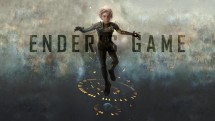Ender’s Game (by Orson Scot Card)

Make no mistake. This is a Young Adult book. It masquerades as “adult science fiction” on many a best-of list, but it is a novel for the tweens and teens. Unlike Ender – who between the ages of 6 and 11 trains day and night to save the world – this book is just too juvenile to impress grown-ups . Far be it from us at TVC to suggest that calling this a novel for adults is to misguide the reader, but let’s just say that it is a bit like promoting Harry Potter as a really really good read for grown-ups too. If you want to encourage a computer-game-playing boy aged between, say, 11 and 15 (and it is a book for boys) to read, try throwing a dead-tree or kindle copy of Ender’s Game onto his iPad while saying something casually like,”this is about some kid called Andrew Wiggin who goes to Battle School in outer space and plays combat games in zero-g gravity. In his spare time he plays a virtual reality game that is designed just for him. Also he commands fleets of simulation starships so that one day he can kill off a whole lot of aliens called “buggers”. Oh and although he’s really small he flips a few people around and breaks their bones. Sounds stupid to me,” and see if it takes.
The plain, fast-paced writing is intense and dramatic enough to keep a child reading. Ender is an appealing character who manages to (just) hold his own in the midst of loneliness, confusion, victimisation and endless overwork.
“‘An enemy, Ender Wiggin’ whispered the old man ‘I am your enemy, the first one you’ve ever had who was smarter than you. There is no teacher but the enemy. No one but the enemy will ever tell you what the enemy is going to do. No one but the enemy will ever teach you how to destroy and conquer. Only the enemy shows you where you are weak. Only the enemy tells you where he is strong. And the only rules of the game are what you can do to him and what you can stop him from doing to you. I am your enemy from now on. From now on I am your teacher’,
Then the old man let Ender’s legs fall. Because he still held Ender’s head to the floor, the boy couldn’t use his arms to compensate, and his legs hit the surface with a loud crack and a sickening pain Then the old man stood and let Ender rise;
Slowly Ender pulled his legs under him, with a faint groan of pain. He knelt on all fours for a moment, recovering. Then his right arm flashed out, reaching for his enemy. The old man quickly danced back, and Ender’s hand closed on air as his teacher’s foot shot forward to catch Ender on the chin”.
The Battle Room parts of the book will probably cause any reader to ask – why do the children’s armies fight without supervision? Why is it fellow-student Ender who has the idea of drilling the soldiers in special manoeuvres? Why is it only Ender who has worked out that there is no up or down in gravity free fields? Why is the idea of presenting the smallest target possible to the enemy so new? Isn’t using an almost invisible wire cheating? But these and other inconsistencies might not bother a youger reader, becauses the battle room passages are quite exciting (if somewhat repetitious).
Card uses the time-honoured device of casting the thoughts of those overseeing the Ender’s progress in a disembodied dialogue at the opening of each chapter. It doesn’t quite work but does cut down on exposition which the younger reader might find boring.
Back on Earth Ender’s equally brilliant siblings are busy being important too. They were rejected by the International Fleet because brother Peter was too sadistic and sister Valentine was too compassionate (we told you this was a boys’ book, didn’t we?). In an (unintendedly) amusing sub-plot the two get bored after a bit when they haven’t heard from Ender — and so they form an uneasy online alliance within which they manipulate global politics and economics tweet by tweet (We told you this was a children’s book, didn’t we?).
The twist is well-handled, but not entirely unexpected. An inexperienced reader may not see it coming and may not immediately see that it raises more questions than it answers. The metaphysical post-script (shades of Murakami) is a pleasant surprise and suggests the sequels might be worth reading – if you are a boy.
So, leave this book to the kids. The violence, sexism and Americanisation won’t hurt them because in essence this is a page-turner about hard work paying off, But for the love of all that is good, before you give the book to your own little Ender, rip out or delete the author’s teary-eyed, nauseatingly self-congratulatory introduction. No-one of any age should be exposed to that.
Leave a comment...
While your email address is required to post a comment, it will NOT be published.


0 Comments